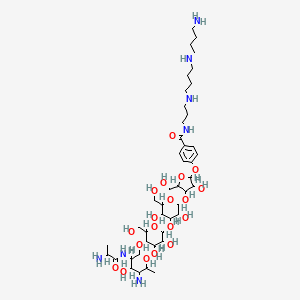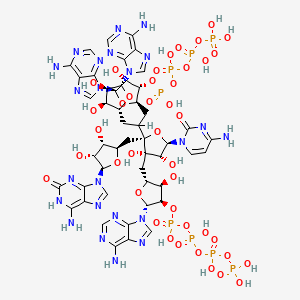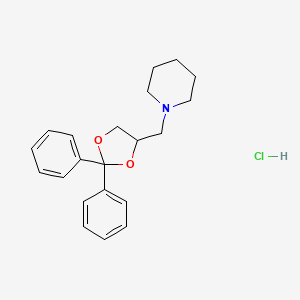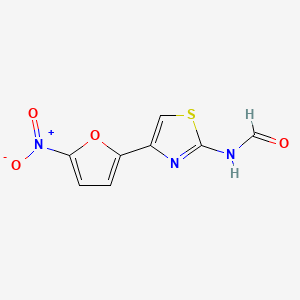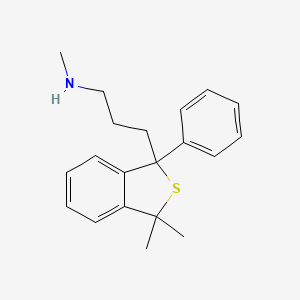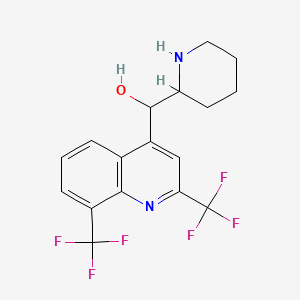
メフロキン
概要
説明
(2,8-bis(trifluoromethyl)quinolin-4-yl)(piperidin-2-yl)methanol is a synthetic antimalarial agent used for the prevention and treatment of malaria caused by Plasmodium falciparum and Plasmodium vivax . It was developed by the United States Army in the 1970s and came into use in the mid-1980s . (2,8-bis(trifluoromethyl)quinolin-4-yl)(piperidin-2-yl)methanol is known for its effectiveness in areas where malaria parasites have developed resistance to other antimalarial drugs .
作用機序
Target of Action
Mefloquine primarily targets the 80S ribosome of the Plasmodium falciparum, a parasite responsible for malaria . The 80S ribosome plays a crucial role in protein synthesis within the parasite, making it a key target for antimalarial drugs.
Mode of Action
Mefloquine interacts with its target by inhibiting protein synthesis, leading to subsequent schizonticidal effects . This means it kills the schizont stage of the parasite, which is a part of the parasite’s life cycle where it multiplies within the host’s red blood cells. Additionally, membrane-bound mefloquine may inhibit merozoite invasion and interact with proteins involved with parasite membrane lipid trafficking and nutrient uptake .
Biochemical Pathways
It is known that mefloquine disrupts protein synthesis, which is a critical process for the survival and multiplication of the malaria parasite . Furthermore, mefloquine binds to haem, forming a complex that may also be toxic to the parasite .
科学的研究の応用
(2,8-bis(trifluoromethyl)quinolin-4-yl)(piperidin-2-yl)methanol has a wide range of scientific research applications:
Chemistry: Used as a starting material for synthesizing other quinoline derivatives.
Biology: Studied for its effects on cellular processes and viability.
Medicine: Primarily used for malaria prophylaxis and treatment.
Industry: Used in the formulation of antimalarial drugs and in research for developing new therapeutic agents.
生化学分析
Biochemical Properties
Mefloquine plays a significant role in biochemical reactions, particularly in its interaction with the malaria parasite. It targets the 80S ribosome of Plasmodium falciparum, inhibiting protein synthesis and causing schizonticidal effects . The compound interacts with various biomolecules, including enzymes and proteins involved in the parasite’s metabolic processes. Mefloquine’s interaction with these biomolecules disrupts the parasite’s ability to replicate and survive within the host .
Cellular Effects
Mefloquine affects various types of cells and cellular processes. It has been shown to influence cell signaling pathways, gene expression, and cellular metabolism. In malaria parasites, mefloquine disrupts the normal function of the digestive vacuole, leading to the accumulation of toxic heme and subsequent parasite death . In mammalian cells, mefloquine can cause neuropsychiatric side effects, including anxiety, depression, and hallucinations . These effects are thought to be related to its impact on neurotransmitter systems and neuronal function .
Molecular Mechanism
The molecular mechanism of mefloquine involves its binding interactions with biomolecules, enzyme inhibition, and changes in gene expression. Mefloquine binds to the 80S ribosome of Plasmodium falciparum, inhibiting protein synthesis and leading to the death of the parasite . Additionally, mefloquine has been shown to inhibit the activity of enzymes involved in the parasite’s metabolic pathways, further disrupting its ability to survive . Changes in gene expression in response to mefloquine treatment have also been observed, contributing to its antimalarial effects .
Temporal Effects in Laboratory Settings
In laboratory settings, the effects of mefloquine change over time. The compound is stable under normal storage conditions, but it can degrade when exposed to light and heat . Long-term studies have shown that mefloquine can have persistent effects on cellular function, including neuropsychiatric side effects that may last for several months after discontinuation of the drug . These long-term effects are thought to be related to the compound’s long half-life and its accumulation in tissues .
Dosage Effects in Animal Models
The effects of mefloquine vary with different dosages in animal models. At therapeutic doses, mefloquine is effective in preventing and treating malaria without causing significant adverse effects . At higher doses, mefloquine can cause toxic effects, including neuropsychiatric symptoms and damage to the liver and kidneys . Studies in rats have shown that mefloquine induces dose-related changes in spontaneous activity and motor function, with higher doses leading to more severe effects .
Metabolic Pathways
Mefloquine is heavily metabolized in the liver by the CYP3A4 enzyme . Two main metabolites have been identified: 2,8-bis-trifluoromethyl-4-quinoline carboxylic acid, which is inactive against Plasmodium falciparum, and a minor alcohol metabolite . The metabolism of mefloquine affects its efficacy and toxicity, with variations in metabolic pathways potentially influencing individual responses to the drug .
Transport and Distribution
Mefloquine is transported and distributed within cells and tissues through various mechanisms. It is absorbed from the gastrointestinal tract, with food significantly increasing its absorption and bioavailability . Once in the bloodstream, mefloquine is distributed to various tissues, including the liver, spleen, and brain . The compound’s distribution is influenced by its binding to plasma proteins and its ability to cross the blood-brain barrier .
Subcellular Localization
The subcellular localization of mefloquine affects its activity and function. In malaria parasites, mefloquine accumulates in the digestive vacuole, where it disrupts the parasite’s metabolic processes . In mammalian cells, mefloquine can localize to the brain, where it affects neurotransmitter systems and neuronal function . The compound’s localization is influenced by its chemical properties and interactions with cellular transporters and binding proteins .
準備方法
Synthetic Routes and Reaction Conditions
(2,8-bis(trifluoromethyl)quinolin-4-yl)(piperidin-2-yl)methanol is synthesized through a multi-step process starting from 2,8-bis(trifluoromethyl)quinoline . The key steps involve:
Formation of the quinoline ring: This is achieved through the Skraup synthesis, where aniline derivatives react with glycerol and sulfuric acid.
Introduction of the trifluoromethyl groups: This is done using trifluoromethylation reagents such as trifluoromethyl iodide.
Formation of the piperidine ring: The final step involves the reaction of the quinoline derivative with piperidine under basic conditions.
Industrial Production Methods
Industrial production of mefloquine involves similar synthetic routes but on a larger scale. The process is optimized for higher yields and purity, often involving advanced purification techniques such as recrystallization and chromatography .
化学反応の分析
Types of Reactions
(2,8-bis(trifluoromethyl)quinolin-4-yl)(piperidin-2-yl)methanol undergoes several types of chemical reactions, including:
Oxidation: (2,8-bis(trifluoromethyl)quinolin-4-yl)(piperidin-2-yl)methanol can be oxidized to form various metabolites.
Reduction: Reduction reactions can modify the quinoline ring.
Substitution: Halogenation and alkylation reactions can introduce different functional groups.
Common Reagents and Conditions
Oxidation: Common oxidizing agents include potassium permanganate and hydrogen peroxide.
Reduction: Reducing agents such as lithium aluminum hydride are used.
Substitution: Halogenation is typically carried out using halogenating agents like chlorine or bromine.
Major Products
The major products formed from these reactions include various quinoline derivatives and piperidine analogs, which can have different pharmacological properties .
類似化合物との比較
(2,8-bis(trifluoromethyl)quinolin-4-yl)(piperidin-2-yl)methanol is often compared with other antimalarial drugs such as chloroquine, hydroxychloroquine, and atovaquone-proguanil .
Chloroquine and Hydroxychloroquine: These are 4-aminoquinoline compounds that are structurally similar to mefloquine but differ in their side chain modifications.
Atovaquone-Proguanil: This combination is used as an alternative to mefloquine for malaria prophylaxis.
(2,8-bis(trifluoromethyl)quinolin-4-yl)(piperidin-2-yl)methanol’s uniqueness lies in its ability to remain effective in regions with high resistance to other antimalarial drugs, making it a valuable tool in the fight against malaria .
特性
IUPAC Name |
[2,8-bis(trifluoromethyl)quinolin-4-yl]-piperidin-2-ylmethanol | |
|---|---|---|
| Source | PubChem | |
| URL | https://pubchem.ncbi.nlm.nih.gov | |
| Description | Data deposited in or computed by PubChem | |
InChI |
InChI=1S/C17H16F6N2O/c18-16(19,20)11-5-3-4-9-10(15(26)12-6-1-2-7-24-12)8-13(17(21,22)23)25-14(9)11/h3-5,8,12,15,24,26H,1-2,6-7H2 | |
| Source | PubChem | |
| URL | https://pubchem.ncbi.nlm.nih.gov | |
| Description | Data deposited in or computed by PubChem | |
InChI Key |
XEEQGYMUWCZPDN-UHFFFAOYSA-N | |
| Source | PubChem | |
| URL | https://pubchem.ncbi.nlm.nih.gov | |
| Description | Data deposited in or computed by PubChem | |
Canonical SMILES |
C1CCNC(C1)C(C2=CC(=NC3=C2C=CC=C3C(F)(F)F)C(F)(F)F)O | |
| Source | PubChem | |
| URL | https://pubchem.ncbi.nlm.nih.gov | |
| Description | Data deposited in or computed by PubChem | |
Molecular Formula |
C17H16F6N2O | |
| Source | PubChem | |
| URL | https://pubchem.ncbi.nlm.nih.gov | |
| Description | Data deposited in or computed by PubChem | |
DSSTOX Substance ID |
DTXSID50860636 | |
| Record name | [2,8-Bis(trifluoromethyl)quinolin-4-yl](piperidin-2-yl)methanol | |
| Source | EPA DSSTox | |
| URL | https://comptox.epa.gov/dashboard/DTXSID50860636 | |
| Description | DSSTox provides a high quality public chemistry resource for supporting improved predictive toxicology. | |
Molecular Weight |
378.31 g/mol | |
| Source | PubChem | |
| URL | https://pubchem.ncbi.nlm.nih.gov | |
| Description | Data deposited in or computed by PubChem | |
Physical Description |
Solid | |
| Record name | Mefloquine | |
| Source | Human Metabolome Database (HMDB) | |
| URL | http://www.hmdb.ca/metabolites/HMDB0014502 | |
| Description | The Human Metabolome Database (HMDB) is a freely available electronic database containing detailed information about small molecule metabolites found in the human body. | |
| Explanation | HMDB is offered to the public as a freely available resource. Use and re-distribution of the data, in whole or in part, for commercial purposes requires explicit permission of the authors and explicit acknowledgment of the source material (HMDB) and the original publication (see the HMDB citing page). We ask that users who download significant portions of the database cite the HMDB paper in any resulting publications. | |
Boiling Point |
415.7±40.0 °C | |
| Record name | Mefloquine | |
| Source | DrugBank | |
| URL | https://www.drugbank.ca/drugs/DB00358 | |
| Description | The DrugBank database is a unique bioinformatics and cheminformatics resource that combines detailed drug (i.e. chemical, pharmacological and pharmaceutical) data with comprehensive drug target (i.e. sequence, structure, and pathway) information. | |
| Explanation | Creative Common's Attribution-NonCommercial 4.0 International License (http://creativecommons.org/licenses/by-nc/4.0/legalcode) | |
Solubility |
3.80e-02 g/L | |
| Record name | Mefloquine | |
| Source | DrugBank | |
| URL | https://www.drugbank.ca/drugs/DB00358 | |
| Description | The DrugBank database is a unique bioinformatics and cheminformatics resource that combines detailed drug (i.e. chemical, pharmacological and pharmaceutical) data with comprehensive drug target (i.e. sequence, structure, and pathway) information. | |
| Explanation | Creative Common's Attribution-NonCommercial 4.0 International License (http://creativecommons.org/licenses/by-nc/4.0/legalcode) | |
| Record name | Mefloquine | |
| Source | Human Metabolome Database (HMDB) | |
| URL | http://www.hmdb.ca/metabolites/HMDB0014502 | |
| Description | The Human Metabolome Database (HMDB) is a freely available electronic database containing detailed information about small molecule metabolites found in the human body. | |
| Explanation | HMDB is offered to the public as a freely available resource. Use and re-distribution of the data, in whole or in part, for commercial purposes requires explicit permission of the authors and explicit acknowledgment of the source material (HMDB) and the original publication (see the HMDB citing page). We ask that users who download significant portions of the database cite the HMDB paper in any resulting publications. | |
Density |
Crystal density: 1.432 g/cu cm | |
| Record name | MEFLOQUINE | |
| Source | Hazardous Substances Data Bank (HSDB) | |
| URL | https://pubchem.ncbi.nlm.nih.gov/source/hsdb/6853 | |
| Description | The Hazardous Substances Data Bank (HSDB) is a toxicology database that focuses on the toxicology of potentially hazardous chemicals. It provides information on human exposure, industrial hygiene, emergency handling procedures, environmental fate, regulatory requirements, nanomaterials, and related areas. The information in HSDB has been assessed by a Scientific Review Panel. | |
Mechanism of Action |
The mechanism of action of mefloquine is not completely understood. Some studies suggest that mefloquine specifically targets the 80S ribosome of the Plasmodium falciparum, inhibiting protein synthesis and causing subsequent schizonticidal effects. There are other studies in the literature with limited in vitro data on mefloquine's mechanism of action., Mefloquine, like chloroquine and quinine, is a blood schizonticidal agent and is active against the intraerythrocytic stages of parasite development. Similar to chloroquine and quinine, mefloquine appears to interfere with the parasite's ability to metabolize and utilize erythrocyte hemoglobin. The antimalarial activity of mefloquine may depend on the ability of the drug to form hydrogen bonds with cellular constituents; results of structure-activity studies indicate that the orientation of the hydroxyl and amine groups with respect to each other in the mefloquine molecule may be essential for antimalarial activity. While the precise mechanism of action of mefloquine is unknown, it may involve mechanisms that differ from those proposed for chloroquine., The effects of the antimalarial drug, mefloquine, on the uptake and release of Ca2+ by crude microsomes from dog brain were investigated using a spectrophotometric method. Mefloquine inhibited the inositol-1,4,5-phosphate (IP3)-induced Ca2+ release with an IC50 of 42 uM, but was a weaker inhibitor of the uptake of Ca2+ into the vesicles (IC50: 272 uM). These effects of mefloquine are in contrast to its actions on Ca2+ uptake and release by skeletal muscle microsomes, where its predominant effect was seen to be the inhibition of Ca2+ uptake into the vesicles. Mefloquine was found to be more potent than quinine as a specific inhibitor of Ca2+ release from IP3-sensitive stores in dog brain microsomes. The possibility of the drug affecting cellular IP3-linked signal transduction processes should be considered. | |
| Record name | Mefloquine | |
| Source | DrugBank | |
| URL | https://www.drugbank.ca/drugs/DB00358 | |
| Description | The DrugBank database is a unique bioinformatics and cheminformatics resource that combines detailed drug (i.e. chemical, pharmacological and pharmaceutical) data with comprehensive drug target (i.e. sequence, structure, and pathway) information. | |
| Explanation | Creative Common's Attribution-NonCommercial 4.0 International License (http://creativecommons.org/licenses/by-nc/4.0/legalcode) | |
| Record name | MEFLOQUINE | |
| Source | Hazardous Substances Data Bank (HSDB) | |
| URL | https://pubchem.ncbi.nlm.nih.gov/source/hsdb/6853 | |
| Description | The Hazardous Substances Data Bank (HSDB) is a toxicology database that focuses on the toxicology of potentially hazardous chemicals. It provides information on human exposure, industrial hygiene, emergency handling procedures, environmental fate, regulatory requirements, nanomaterials, and related areas. The information in HSDB has been assessed by a Scientific Review Panel. | |
CAS No. |
49752-90-1, 53230-10-7 | |
| Record name | α-(2-Piperidyl)-2,8-bis(trifluoromethyl)-4-quinolinemethanol | |
| Source | CAS Common Chemistry | |
| URL | https://commonchemistry.cas.org/detail?cas_rn=49752-90-1 | |
| Description | CAS Common Chemistry is an open community resource for accessing chemical information. Nearly 500,000 chemical substances from CAS REGISTRY cover areas of community interest, including common and frequently regulated chemicals, and those relevant to high school and undergraduate chemistry classes. This chemical information, curated by our expert scientists, is provided in alignment with our mission as a division of the American Chemical Society. | |
| Explanation | The data from CAS Common Chemistry is provided under a CC-BY-NC 4.0 license, unless otherwise stated. | |
| Record name | alpha-2-Piperidyl-2,8-bis(trifluoromethyl)quinoline-4-methanol | |
| Source | ChemIDplus | |
| URL | https://pubchem.ncbi.nlm.nih.gov/substance/?source=chemidplus&sourceid=0049752901 | |
| Description | ChemIDplus is a free, web search system that provides access to the structure and nomenclature authority files used for the identification of chemical substances cited in National Library of Medicine (NLM) databases, including the TOXNET system. | |
| Record name | Mefloquine | |
| Source | DrugBank | |
| URL | https://www.drugbank.ca/drugs/DB00358 | |
| Description | The DrugBank database is a unique bioinformatics and cheminformatics resource that combines detailed drug (i.e. chemical, pharmacological and pharmaceutical) data with comprehensive drug target (i.e. sequence, structure, and pathway) information. | |
| Explanation | Creative Common's Attribution-NonCommercial 4.0 International License (http://creativecommons.org/licenses/by-nc/4.0/legalcode) | |
| Record name | α-2-piperidyl-2,8-bis(trifluoromethyl)quinoline-4-methanol | |
| Source | European Chemicals Agency (ECHA) | |
| URL | https://echa.europa.eu/substance-information/-/substanceinfo/100.051.318 | |
| Description | The European Chemicals Agency (ECHA) is an agency of the European Union which is the driving force among regulatory authorities in implementing the EU's groundbreaking chemicals legislation for the benefit of human health and the environment as well as for innovation and competitiveness. | |
| Explanation | Use of the information, documents and data from the ECHA website is subject to the terms and conditions of this Legal Notice, and subject to other binding limitations provided for under applicable law, the information, documents and data made available on the ECHA website may be reproduced, distributed and/or used, totally or in part, for non-commercial purposes provided that ECHA is acknowledged as the source: "Source: European Chemicals Agency, http://echa.europa.eu/". Such acknowledgement must be included in each copy of the material. ECHA permits and encourages organisations and individuals to create links to the ECHA website under the following cumulative conditions: Links can only be made to webpages that provide a link to the Legal Notice page. | |
| Record name | MEFLOQUINE | |
| Source | Hazardous Substances Data Bank (HSDB) | |
| URL | https://pubchem.ncbi.nlm.nih.gov/source/hsdb/6853 | |
| Description | The Hazardous Substances Data Bank (HSDB) is a toxicology database that focuses on the toxicology of potentially hazardous chemicals. It provides information on human exposure, industrial hygiene, emergency handling procedures, environmental fate, regulatory requirements, nanomaterials, and related areas. The information in HSDB has been assessed by a Scientific Review Panel. | |
| Record name | Mefloquine | |
| Source | Human Metabolome Database (HMDB) | |
| URL | http://www.hmdb.ca/metabolites/HMDB0014502 | |
| Description | The Human Metabolome Database (HMDB) is a freely available electronic database containing detailed information about small molecule metabolites found in the human body. | |
| Explanation | HMDB is offered to the public as a freely available resource. Use and re-distribution of the data, in whole or in part, for commercial purposes requires explicit permission of the authors and explicit acknowledgment of the source material (HMDB) and the original publication (see the HMDB citing page). We ask that users who download significant portions of the database cite the HMDB paper in any resulting publications. | |
Melting Point |
250-254, 174-176 °C | |
| Record name | Mefloquine | |
| Source | DrugBank | |
| URL | https://www.drugbank.ca/drugs/DB00358 | |
| Description | The DrugBank database is a unique bioinformatics and cheminformatics resource that combines detailed drug (i.e. chemical, pharmacological and pharmaceutical) data with comprehensive drug target (i.e. sequence, structure, and pathway) information. | |
| Explanation | Creative Common's Attribution-NonCommercial 4.0 International License (http://creativecommons.org/licenses/by-nc/4.0/legalcode) | |
| Record name | MEFLOQUINE | |
| Source | Hazardous Substances Data Bank (HSDB) | |
| URL | https://pubchem.ncbi.nlm.nih.gov/source/hsdb/6853 | |
| Description | The Hazardous Substances Data Bank (HSDB) is a toxicology database that focuses on the toxicology of potentially hazardous chemicals. It provides information on human exposure, industrial hygiene, emergency handling procedures, environmental fate, regulatory requirements, nanomaterials, and related areas. The information in HSDB has been assessed by a Scientific Review Panel. | |
Retrosynthesis Analysis
AI-Powered Synthesis Planning: Our tool employs the Template_relevance Pistachio, Template_relevance Bkms_metabolic, Template_relevance Pistachio_ringbreaker, Template_relevance Reaxys, Template_relevance Reaxys_biocatalysis model, leveraging a vast database of chemical reactions to predict feasible synthetic routes.
One-Step Synthesis Focus: Specifically designed for one-step synthesis, it provides concise and direct routes for your target compounds, streamlining the synthesis process.
Accurate Predictions: Utilizing the extensive PISTACHIO, BKMS_METABOLIC, PISTACHIO_RINGBREAKER, REAXYS, REAXYS_BIOCATALYSIS database, our tool offers high-accuracy predictions, reflecting the latest in chemical research and data.
Strategy Settings
| Precursor scoring | Relevance Heuristic |
|---|---|
| Min. plausibility | 0.01 |
| Model | Template_relevance |
| Template Set | Pistachio/Bkms_metabolic/Pistachio_ringbreaker/Reaxys/Reaxys_biocatalysis |
| Top-N result to add to graph | 6 |
Feasible Synthetic Routes
A: Mefloquine induces cell death in leukemia and myeloma cells primarily through the induction of reactive oxygen species (ROS). This process is dependent on the activation of STAT1, a transcription factor downstream of the Toll-like receptor and interferon (TLR-IFN) signaling pathways. []
A: Mefloquine activates the TLR-IFN cytokine axis in leukemia cells, leading to the activation of STAT1 and NF-κB transcription factors. This activation, in turn, triggers a cascade of events that ultimately results in ROS production. []
A: Research suggests that Mefloquine exhibits activity against various parasites, potentially by inhibiting connexin 26 hemichannels. This inhibition has been observed in Xenopus laevis oocytes and is believed to contribute to its efficacy against KID syndrome. [] Studies also suggest that Mefloquine may disrupt cell membranes in certain bacteria, contributing to its bactericidal effects. []
A: The molecular formula of Mefloquine hydrochloride is C17H16F6N2O•HCl•0.5CH3OH, and its molecular weight is 430.8 g/mol. []
A: Mefloquine hydrochloride crystallizes as a secondary amine salt with channels of disordered methanol solvent. It exhibits a tetragonal crystal system with the space group P42/n. []
A: Yes, 1H-NMR studies suggest that the erythro isomer of Mefloquine hydrochloride exists predominantly in one conformation in solution, while the threo isomer exists as a mixed population of two stable conformers. []
A: Yes, molecular mechanics calculations using the MMX force field have been employed to determine the minimum energy conformations of Mefloquine and related compounds. This approach aids in understanding the structure-activity relationships of these molecules. []
A: Studies on the isolated mouse phrenic nerve diaphragm preparation revealed that the erythro and threo isomers of Mefloquine exhibit distinct pharmacological profiles. The erythro isomer primarily induces muscle contraction and inhibits both indirectly and directly stimulated twitch responses. In contrast, the threo isomer lacks contractile effects but potentiates directly stimulated twitch responses. []
A: Research suggests that a piperidine methanol group attached to pyridine, quinoline, or benzylquinoline ring systems is crucial for the antimicrobial activity of Mefloquine analogs. Compounds with these structural features displayed significant activity against gram-positive bacteria, including Staphylococcus and Streptococcus species. []
A: Researchers are investigating novel organic salts of Mefloquine to enhance its pharmaceutical properties. For instance, Mefloquine mesylate demonstrated increased water solubility compared to Mefloquine hydrochloride. Furthermore, most of the newly synthesized salts exhibited improved permeability and diffusion through synthetic membranes, with the exception of Mefloquine docusate. These findings highlight the potential of organic salts in optimizing Mefloquine formulations. []
A: In vitro studies have shown that Mefloquine exhibits more potent and rapid amoebicidal activity against E. histolytica trophozoites compared to Metronidazole. Additionally, Mefloquine effectively killed the cysts of a related reptilian parasite, Entamoeba invadens, while Metronidazole did not. []
A: Resistance to Mefloquine in P. falciparum is often associated with amplification and overexpression of the pfmdr1 gene, which encodes the P-glycoprotein homologue 1 (Pgh1) transporter. This transporter is believed to efflux Mefloquine from the parasite's digestive vacuole, reducing its efficacy. [, ]
A: Yes, studies indicate that Mefloquine resistance in P. falciparum is linked to cross-resistance with halofantrine and quinine. This cross-resistance is thought to stem from the increased expression of the pfmdr1 gene, which affects the parasite's susceptibility to multiple drugs. []
A: While not conclusively established, research suggests a potential interaction between Mefloquine and the P-glycoprotein (P-gp) transporter. This transporter plays a crucial role in drug efflux and may influence the distribution and elimination of Mefloquine, potentially contributing to its pharmacokinetic profile. [, ]
A: In vitro studies using microsomes from various species suggest that Mefloquine undergoes phase I hepatic metabolism, primarily by cytochrome P450 (CYP) enzymes. Feline and common brush-tailed possum microsomes effectively metabolized Mefloquine, while the process was much slower in canine microsomes. []
A: Several alternatives to Mefloquine exist for malaria treatment, each with its own efficacy and safety profile. Some commonly used options include: * Atovaquone/Proguanil: This combination therapy has demonstrated high efficacy against multidrug-resistant P. falciparum malaria and is generally well-tolerated. [] * Artesunate plus Mefloquine: This combination is also effective in areas with low malaria transmission, with higher cure rates observed compared to Mefloquine alone. [] * Pyronaridine-artesunate: This fixed-dose combination therapy has shown promising results in treating uncomplicated P. falciparum malaria. [] * Dihydroartemisinin-Piperaquine: This ACT can be safely combined with Mefloquine for treating multidrug-resistant malaria. [] * Halofantrine: Though effective, its use is limited due to a higher risk of cardiac toxicity. [, ]
A: Mefloquine was developed by the Walter Reed Army Institute of Research and Roche Laboratories and was approved for malaria treatment by the US Food and Drug Administration in 1989. It was initially marketed under the trade name Lariam. []
A: Research suggests that Mefloquine may have potential applications in treating other diseases: * Echinococcosis: Both in vitro and in vivo studies have indicated its potential efficacy against alveolar echinococcosis, a parasitic disease caused by the tapeworm Echinococcus multilocularis. [] * Tuberculosis: Mefloquine exhibits bactericidal activity against Mycobacterium tuberculosis strains, including multidrug-resistant strains, in vitro and within macrophages. [] * Amoebiasis: Mefloquine demonstrates potent in vitro activity against Entamoeba histolytica, suggesting its potential as a future treatment option. []
試験管内研究製品の免責事項と情報
BenchChemで提示されるすべての記事および製品情報は、情報提供を目的としています。BenchChemで購入可能な製品は、生体外研究のために特別に設計されています。生体外研究は、ラテン語の "in glass" に由来し、生物体の外で行われる実験を指します。これらの製品は医薬品または薬として分類されておらず、FDAから任何の医療状態、病気、または疾患の予防、治療、または治癒のために承認されていません。これらの製品を人間または動物に体内に導入する形態は、法律により厳格に禁止されています。これらのガイドラインに従うことは、研究と実験において法的および倫理的な基準の遵守を確実にするために重要です。


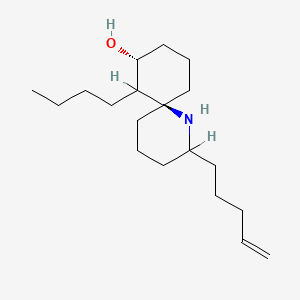
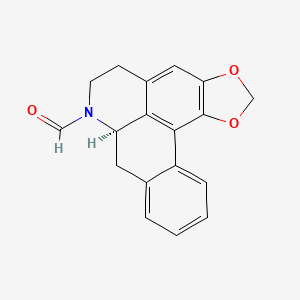
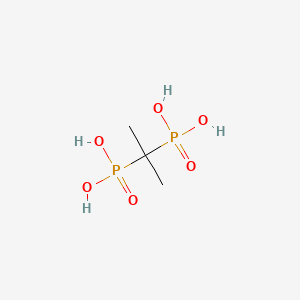
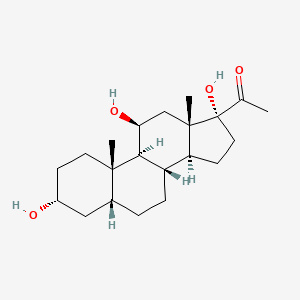
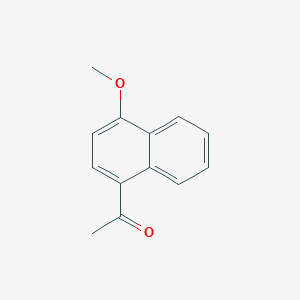
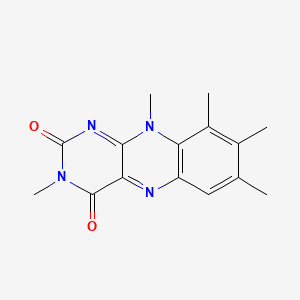
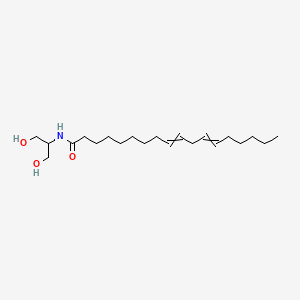
![(4aR,4bS,6aS,6bR,10aR,11aS,11bR)-6b-acetyl-4a,6a,13-trimethyl-4,4b,5,6,7,8,9,10,10a,11,11a,11b-dodecahydro-3H-indeno[2,1-a]phenanthren-2-one;(8R,9S,13S,14S)-17-ethynyl-3-methoxy-13-methyl-7,8,9,11,12,14,15,16-octahydro-6H-cyclopenta[a]phenanthren-17-ol](/img/structure/B1219369.png)
